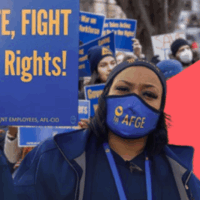They began early in the morning, before dawn, in cities up and down the East Coast this Tuesday, and then spread westward all across the country throughout the day and into the evening. Tens of thousands of low-wage workers, joining strikes by fast food workers, staging rallies and marches to city halls calling for a $15 minimum wage and union rights.

Workers rally in the early morning hours in Brooklyn, NY, as the nation’s largest-yet Fight for $15 demonstrations get underway on Tuesday, November 10, 2015.
In 270 cities and towns, tens of thousands of low-wage workers joined the Fight for $15 November 10 day of action, taking to the streets in the movement’s largest nationwide demonstration to build worker power yet. One year out from the 2016 elections, the protests also looked to turn that power toward electoral contests, calling on candidates for public office to join the fight for higher wages, with the slogan “Come Get My Vote.”
“Low-wage workers across the country today are offering a glimpse of the power that comes with their unified voice,” said Christine Owens, executive director of the National Employment Law Project, “and candidates gearing up for the 2016 elections across the country should take note of their urgent calls for change.”
An estimated 1,000 protesters marched Tuesday night from the city hall in Milwaukee to the auditorium where a Republican presidential debate was being held.
The protest prompted the main debate’s first question for the current GOP poll-leaders Donald Trump and Ben Carson from moderator Neil Cavuto, who asked if they sympathized with the low-wage workers and would support raising the federal minimum wage.
They both rejected any increase in the minimum wage, with Trump saying he thinks that U.S. workers’ “wages are too high” and Carson saying “I would not raise it,” asserting “every time we raise the minimum wage, the number of jobless people increases” – a claim that fact-checkers immediately labeled “false.”
Florida Senator Marco Rubio, another Republican presidential candidate, then said that he too opposes raising the federal minimum wage, currently stuck at a poverty-level $7.25 per hour, asserting that doing so would “make people more expensive than a machine” – a curious statement given that the senator has previously said “You can’t live on $10 an hour. You can’t live on $11 an hour.”
Still, the Fight for $15 movement is increasingly forcing the urgent need to raise wages to the center of the policy and political debates. And more and more public officials are responding positively to the momentum toward a $15 minimum wage.
At a rally with low-wage workers Tuesday, New York Governor Andrew Cuomo announced he is instituting a phased-in $15 minimum wage for all state government workers, by 2018 in New York City and 2021 statewide, making New York the first state in the nation with a $15 minimum wage for state employees.
Also on Tuesday, Mayor Bill Peduto of Pittsburgh, Pennsylvania, issued an executive order setting a $15 minimum wage for all city employees by 2021.
Forty-two percent of America’s non-self-employed workers are paid less than $15 per hour, according to NELP’s updated report The Growing Movement for $15 which tracks the movement’s meteoric rise. That’s a huge constituency capable of wielding considerable power at the ballot box. And, as recent polling shows, they are increasingly inclined to do so.




